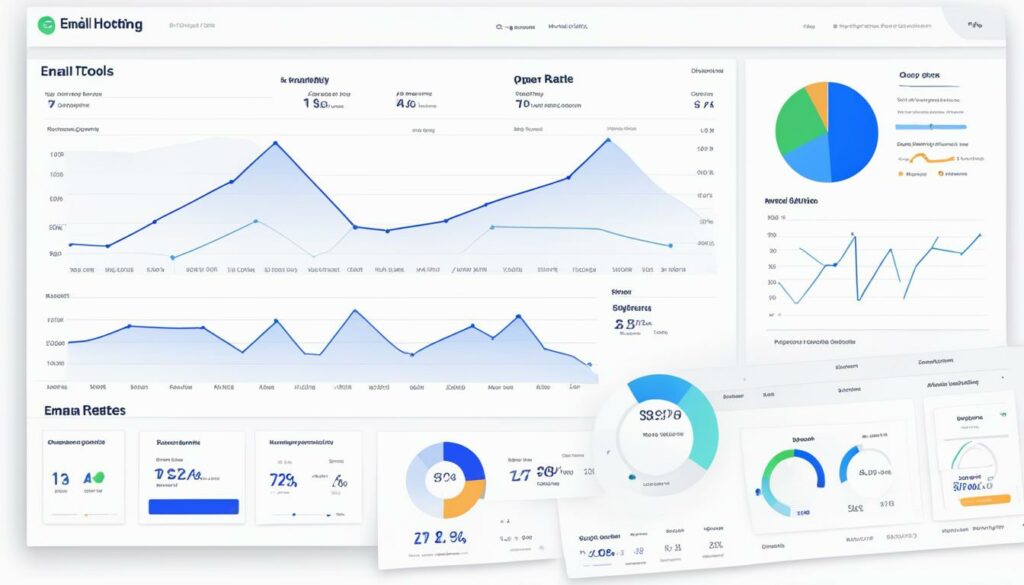Email deliverability is a crucial aspect of any marketing or transactional email campaign. It measures the success of your emails in reaching the intended recipients’ inboxes. However, various challenges can arise, causing issues with email deliverability, such as emails not reaching recipients, high bounce rates, and being flagged as spam.
To troubleshoot email deliverability problems, it’s important to understand the factors that impact it. These include email content, spam filters, sending volume, and infrastructure. By addressing these factors and implementing best practices, you can improve your email deliverability and ensure that your messages are reaching your audience.
To help you improve your email deliverability, BoostedHost offers reliable and optimized WordPress Hosting. With BoostedHost, you can expect optimal performance and a secure hosting environment. Sign up now here to take your email campaigns to the next level.
Key Takeaways:
- Troubleshoot email deliverability issues to ensure your emails reach recipients’ inboxes.
- Understand the factors impacting email deliverability, including email content, spam filters, sending volume, and infrastructure.
- Implement best practices such as email authentication and reputation management to improve deliverability.
- Monitor and benchmark your email deliverability rates to gauge the success of your campaigns.
- Choose a reliable email hosting provider, like BoostedHost, to ensure optimal performance and secure communication.
Understanding Email Deliverability and Delivery
Email delivery and email deliverability are two important concepts that determine the success of your email campaigns. While both terms are related to the transmission of emails, they have distinct meanings.
When we talk about email delivery, we refer to whether the recipient’s mail server accepted the email file and delivered it to the mailbox. In simpler terms, it is about whether the email reached its intended destination regardless of the folder it landed in.
On the other hand, email deliverability focuses on where the email is placed within the recipient’s mailbox. It goes beyond just delivery and considers whether the email was placed in the inbox or other folders that may rarely be checked by the recipient.
Understanding the difference between delivery and deliverability is crucial because it directly impacts your communication with recipients. Low email deliverability can lead to important messages being missed or overlooked.
Imagine a scenario where a user is locked out of their account and desperately needs instructions to regain access. If the email ends up in their spam folder or gets filtered out, they might never see it, resulting in frustration and potential loss of business for you.
Issues with email deliverability can also lead to users missing out on important updates, promotions, and reminders about your services. To avoid these problems, it is essential to implement strategies that prioritize and improve email deliverability.
By optimizing email deliverability, you ensure that your messages are delivered to the right place at the right time, enabling effective communication and engagement with your audience.
Email Deliverability Challenges and Solutions
Before we dive into specific strategies to improve email deliverability, let’s take a closer look at some common challenges that affect deliverability:
| Challenges | Solutions |
|---|---|
| Email Bounce Rate | Regularly clean your email list to remove invalid or non-existent email addresses. |
| Email Spam Filters | Optimize your email content to avoid spam trigger words and engage with recipients. |
| Email Blacklisting | Maintain a good sender reputation and monitor blacklists to prevent being flagged as a spammer. |
By addressing these challenges and implementing best practices, you can significantly improve your email deliverability and ensure that your messages reach your audience’s inbox.
Common Challenges in Email Deliverability
Email deliverability is essential for ensuring that your messages reach their intended recipients. However, there are various challenges that can hinder the successful delivery of your emails. Understanding and addressing these challenges is crucial for improving email deliverability rates and maximizing the effectiveness of your communication efforts.
High Email Bounce Rates
One common challenge is high email bounce rates. This occurs when an email is sent to an invalid or non-existent email address and is consequently returned to the sender. High bounce rates can negatively impact email deliverability, as they signal to Internet Service Providers (ISPs) that your email list may contain outdated or incorrect information.
Email Spam Filters
Email spam filters are designed to protect users from unwanted or malicious messages. However, these filters can sometimes mistakenly classify legitimate emails as spam, preventing them from reaching the recipient’s inbox. This can be a frustrating challenge, as your carefully crafted emails may end up in the spam folder, diminishing their visibility and impact.
Email Blacklisting
Email blacklisting is another challenge that can significantly impact email deliverability. When an IP address or domain is identified as sending spam, it can be added to a blacklist. Being blacklisted means that emails sent from that source will be automatically blocked by many ISPs, preventing them from reaching recipients’ inboxes. It can be challenging to regain a good sending reputation and remove yourself from a blacklist.
To overcome these challenges, it is important to regularly clean and update your email list, ensuring that you only target active and valid addresses. Additionally, monitoring your email deliverability metrics, such as bounce rates, can help identify issues and allow you to take necessary actions to resolve them. By proactively addressing these common challenges, you can improve email deliverability and increase the chances of your messages reaching the intended recipients.
Strategies to Improve Email Deliverability
When it comes to improving email deliverability, there are a few key strategies you can implement to increase the chances of your emails reaching recipients’ inboxes. Two critical aspects to focus on are email authentication and email reputation management.
Email Authentication
Implementing email authentication protocols, such as Sender Policy Framework (SPF) and DomainKeys Identified Mail (DKIM), is crucial for establishing the authenticity and credibility of your emails. SPF verifies that the email is being sent from an authorized server, while DKIM adds a digital signature to the email to ensure its integrity. By implementing these protocols, you can prevent spoofing and increase the deliverability of your emails.
Email Reputation Management
Your email reputation plays a significant role in determining whether your emails make it to recipients’ inboxes. Internet Service Providers (ISPs) evaluate the reputation of your domain and IP address before delivering your emails. To build a positive email reputation, it’s essential to follow best practices. Avoid practices like buying email lists, sending emails to inactive or uninterested recipients, and using spam trigger words in your subject lines. By maintaining a good email reputation, you will increase the chances of your emails being delivered.
“Implementing email authentication protocols, such as SPF and DKIM, can prevent spoofing and increase deliverability.”
By implementing email authentication and managing your email reputation effectively, you can significantly improve your email deliverability rates. Remember to follow best practices and continuously monitor your email performance to ensure your messages reach the intended recipients’ inboxes.

Benchmarking Email Deliverability Rates
In order to assess the effectiveness of your email campaigns and optimize your marketing efforts, it is crucial to benchmark your email deliverability rates. Understanding industry standards and analyzing engagement and open rates can provide valuable insights into your campaign’s performance. Here are some key benchmarks and considerations for email deliverability:
Email Deliverability Rates
While the ideal email deliverability rate can vary across industries, it is generally recommended to aim for a rate between 85% and 95% for optimal results. This means that your email should successfully reach the recipient’s inbox without being filtered as spam or ending up in other folders.
Engagement Rates
Engagement rates indicate how active and interested your recipients are in your emails. When it comes to marketing emails, the average open rate typically ranges from 20% to 25%. A good open rate for most industries is considered above 30%. Tracking and improving these rates can provide valuable insights into the effectiveness of your email content and subject lines.
Transactional Email Rates
Transactional emails, such as order confirmations or password resets, generally have higher deliverability and open rates compared to marketing emails. These emails are expected by users and tend to have open rates as high as 80% to 85%. Monitoring and optimizing the deliverability of transactional emails is essential for ensuring that important communications reach your users.
By benchmarking and analyzing your email deliverability rates, engagement rates, and open rates, you can gain a better understanding of how your campaigns perform relative to industry standards. This allows you to identify areas for improvement and implement strategies to enhance your email deliverability and engagement.
To help you track and optimize your email deliverability rates, various tools and services are available. These tools provide insights into your email performance, helping you make data-driven decisions to improve your email marketing results.

| Email Deliverability Benchmarks | Industry Average | Best-in-Class |
|---|---|---|
| Marketing Email Open Rates | 20-25% | Above 30% |
| Transactional Email Open Rates | Around 80-85% | Around 80-85% |
Tools for Email Deliverability Testing
When it comes to testing and improving email deliverability, having the right tools is essential. These tools allow you to analyze and optimize your email campaigns, ensuring that your messages reach your recipients’ inboxes. Here are some top email deliverability test tools you can utilize:
1. Mailtrap Email Testing
Mailtrap Email Testing provides an email sandbox that allows you to test your email workflows in a safe environment. With this tool, you can check how your emails appear in various email clients, analyze spam scores to avoid the spam folder, and test the delivery of your emails.
2. Sender Score
Sender Score is a tool that assesses your domain reputation and provides you with a “Sender Score” for each IP address. This score is used by ISPs to evaluate the trustworthiness of your emails. Monitoring and improving your Sender Score can greatly enhance your email deliverability.
3. MXToolbox
MXToolbox offers a range of tools for validating reputation, authentications, and domain health. With this tool, you can monitor and improve the health of your email infrastructure, ensuring that your emails are delivered successfully to your recipients’ inboxes.
4. Mail-tester.com
Mail-tester.com allows you to test the deliverability of your emails by providing you with a unique email address. When you send a test email to this address, Mail-tester.com analyzes the email and provides you with a score, indicating the likelihood of your email being delivered to the inbox.
5. Isnotspam.com
Isnotspam.com is a tool that helps you identify potential spam issues in your emails. By sending your email to their test address, Isnotspam.com analyzes the content and provides you with a detailed spam report, highlighting any areas that could trigger spam filters.
6. Spamcheck by Postmark
Spamcheck by Postmark is a tool that scores your email for spam likelihood. By sending your email to their test address, you can receive a score and recommendations for improving your email deliverability and avoiding the spam folder.
7. SendForensics
SendForensics is a comprehensive email deliverability testing tool that provides insights into authentication, content, and sender reputation. It offers features like spam testing, domain reputation monitoring, and content analysis, allowing you to optimize your emails for maximum deliverability.
8. Glock Apps
Glock Apps is a suite of tools designed to improve email deliverability. It provides spam testing, inbox placement testing, and email reputation monitoring. With Glock Apps, you can identify and fix potential deliverability issues, ensuring your emails reach the intended recipients.
9. Kickbox
Kickbox is an email verification and deliverability monitoring tool. It helps you maintain a clean email list by identifying and removing invalid or risky email addresses. Kickbox also provides insights into your email deliverability, allowing you to monitor and improve your email campaigns.

These are just a few examples of the many email deliverability test tools available. By utilizing these tools, you can ensure that your emails are delivered to your recipients’ inboxes and optimize your email campaigns for maximum effectiveness.
Factors Affecting Email Deliverability
When it comes to email deliverability, several factors can have an impact on whether your emails successfully reach their intended recipients. By understanding and addressing these factors, you can improve the effectiveness of your email campaigns.
1. Spam Complaints: High spam complaint rates indicate that recipients are flagging your emails as spam. This can significantly impact your deliverability. To minimize spam complaints, ensure that your emails are relevant, personalized, and provide value to the recipients.
2. Email Content: The content of your emails, including subject lines and body text, can trigger spam filters and affect deliverability. Avoid using spam trigger words, excessive punctuation, or misleading subject lines. Focus on creating engaging and informative content that encourages recipients to open and engage with your emails.
3. Sending Volume: Sending a large volume of emails in a short period of time can raise red flags and lead to delivery issues. ISPs and email service providers may view this as suspicious activity or spamming behavior. It’s important to manage your sending volume and distribute your emails over a reasonable time frame to ensure better deliverability.
4. Infrastructure: The infrastructure you use, such as your mail server and IP address, can also impact email deliverability. If you’re using a shared IP address or a server with a poor reputation, it may affect your email’s chances of reaching the inbox. Consider using reputable email service providers or improving your infrastructure setup for better deliverability.
By tracking and addressing these factors, you can minimize email deliverability issues and increase the chances of your emails reaching the intended recipients’ inboxes.
| Factors Affecting Email Deliverability | Impact on Deliverability |
|---|---|
| Spam Complaints | High complaint rates can negatively impact deliverability. |
| Email Content | Poorly crafted content can trigger spam filters and affect deliverability. |
| Sending Volume | Sending a large volume of emails in a short period may lead to delivery issues. |
| Infrastructure | Poor infrastructure, such as a shared IP or unreliable servers, can impact deliverability. |
Remember, delivering emails to the inbox is crucial for the success of your email marketing efforts. By addressing these factors and taking proactive steps to improve deliverability, you can maximize the impact of your email campaigns.

Importance of Email Deliverability Monitoring
Email deliverability monitoring is crucial for ensuring that your emails reach recipients’ inboxes and have the desired impact. By tracking the performance of your email campaigns, you can gain valuable insights into open rates, engagement levels, and user behavior. Understanding these metrics helps you make informed decisions to improve email deliverability and optimize your marketing efforts.
One effective way to monitor email deliverability is by tracking open rates. Open rates indicate how many recipients have opened your email, giving you a measure of the campaign’s effectiveness. By analyzing open rates, you can determine whether your subject lines and email content are engaging and compelling enough to prompt recipients to open your emails.
Tracking pixels are another essential tool for email deliverability monitoring. These tiny, transparent images embedded in your emails allow you to track when an email is viewed and if links are clicked. By utilizing tracking pixels, you can gain insights into user behavior, such as which links are most popular or which emails are generating the most engagement.
Many email software and tools offer built-in analytics and tracking capabilities, making it easy to monitor deliverability. These tools provide comprehensive data and reports that allow you to gauge the success of your email campaigns, identify areas for improvement, and refine your strategies accordingly.
Here is a table summarizing the benefits and key features of email deliverability monitoring:
| Benefits of Email Deliverability Monitoring | Key Features |
|---|---|
|
|
Discovering Valuable Insights
Monitoring email deliverability allows you to uncover valuable insights that can shape your email marketing strategy. By understanding how recipients engage with your emails, you can tailor your content, subject lines, and calls to action to better resonate with your audience and drive conversions.
Effective email deliverability monitoring helps you make data-driven decisions, fine-tune your campaigns, and increase the chances of your emails being seen and acted upon. By leveraging the power of tracking pixels and analyzing open rates, you can enhance email deliverability, boost user engagement, and drive the success of your email marketing efforts.
Remember, email deliverability monitoring is an ongoing process that requires regular evaluation and adjustment. By staying proactive and responsive to user behavior, you can continually optimize your email campaigns and achieve the best possible results.
To ensure optimal performance and reliable email deliverability, we recommend BoostedHost’s WordPress Hosting. Sign up now through this link: www.boostedhost.com/wordpress-hosting.
Best Practices for Email Deliverability
Following best practices is essential for improving email deliverability rates. By implementing these practices, you can enhance your sender reputation, optimize email content, and ensure a reliable email infrastructure.
Building a Positive Sender Reputation
Your sender reputation plays a crucial role in email deliverability. Internet Service Providers (ISPs) evaluate the credibility of your domain and IP address before delivering emails. To maintain a positive sender reputation:
- Avoid buying email lists
- Refrain from emailing uninterested recipients
Creating Compelling and Relevant Email Content
The content of your emails greatly impacts deliverability and engagement. To ensure maximum success:
- Write compelling subject lines that capture attention
- Create relevant and personalized email content
Ensuring a Reliable Email Infrastructure
Your email infrastructure should be robust and trustworthy. Consider the following practices:
- Use reliable email servers to prevent delivery issues
- Implement email authentication protocols like SPF and DKIM
To optimize your email deliverability, it’s important to follow these best practices consistently. By doing so, you can increase the chances of your emails reaching the recipients’ inboxes, leading to higher engagement and improved marketing campaign results.
| Best Practices for Email Deliverability | Description |
|---|---|
| Building a Positive Sender Reputation | Avoid buying email lists and emailing uninterested recipients to maintain a good sender reputation. |
| Creating Compelling and Relevant Email Content | Write captivating subject lines and create personalized and relevant email content to increase engagement. |
| Ensuring a Reliable Email Infrastructure | Use reliable email servers and implement email authentication protocols for a trustworthy email infrastructure. |
Importance of Email Hosting for Deliverability
Email hosting plays a crucial role in ensuring efficient and secure communication. With professional email hosting, you can benefit from a dedicated mail server that handles sending, receiving, and encrypting emails. This helps improve email deliverability, ensuring that your messages reach the intended recipients without any issues.
One of the key advantages of email hosting is the ability to have a professional business address. Instead of using generic email providers, such as Gmail or Yahoo, a professional email address with your own domain name adds credibility to your communication. This branding opportunity helps establish trust and enhances your professional image.
Moreover, email hosting provides dedicated disk space for your emails, ensuring that you have ample storage for all your messages and attachments. This eliminates the worry of reaching storage limits and allows you to keep your inbox organized and clutter-free.
When it comes to email security, email hosting offers advanced measures to keep your communication secure. This includes features like encryption, which protects the content of your emails from unauthorized access. By encrypting your emails, you can ensure that sensitive information remains confidential and cannot be intercepted by malicious actors.
“With email hosting, you can safeguard your communication and protect sensitive information from falling into the wrong hands.”
An essential aspect of email hosting is the built-in spam protection it provides. Spam emails can be a major nuisance and can lead to wasted time and potential security risks. With email hosting, you can benefit from robust spam filters that automatically detect and block unwanted emails, reducing clutter and improving productivity.
To make the most of email hosting, it’s important to choose a reliable hosting provider that offers a professional email address and domain. Look for a provider that offers reliable infrastructure and excellent customer support to ensure a smooth experience. One such provider is BoostedHost, known for its high-quality WordPress hosting services and email hosting solutions.
Setting up and managing email inboxes is another crucial aspect of email hosting. You should be able to easily configure and link your email accounts to various devices such as smartphones, tablets, and desktop computers. This flexibility allows you to access your emails anytime, anywhere, ensuring seamless communication on the go.
Implementing productivity strategies like email organization and security measures is important for optimal email hosting. By organizing your emails into folders and labels, you can streamline your workflow and quickly locate important messages. Additionally, implementing measures like two-factor authentication adds an extra layer of security to your email accounts, further enhancing your protection against unauthorized access.
| Email Hosting Benefits | |
|---|---|
| Professional business address | ✔ |
| Dedicated disk space | ✔ |
| Advanced email security | ✔ |
| Robust spam protection | ✔ |
| Reliable infrastructure | ✔ |
| Flexible device compatibility | ✔ |
Overall, email hosting is essential for ensuring efficient and secure email communication. It provides a range of benefits, including a professional business address, dedicated disk space, advanced security measures, and robust spam protection. By choosing a reliable hosting provider and implementing productivity strategies, you can make the most of email hosting and enhance your overall email deliverability.
Ensuring Secure Email Communication with Hosting
Securing email communication is vital for protecting sensitive data and preventing phishing attacks. Implementing email encryption and zero-access encryption ensures that email messages are secure and cannot be intercepted by third parties. Avoiding opening emails from unknown senders and enabling spam filters can protect against phishing attempts. Password protecting emails and using two-factor authentication adds an extra layer of security to email accounts.
When it comes to securing email communication, two essential measures to implement are email encryption and zero-access encryption. Email encryption ensures that your messages are protected during transit and can only be read by the intended recipient. This prevents unauthorized access and keeps your sensitive data safe from prying eyes.
To further enhance the security of your email communication, consider implementing zero-access encryption. With zero-access encryption, your email service provider has no access to the contents of your emails. This means that even if the provider’s servers are breached, your emails remain encrypted and inaccessible to hackers.
In addition to encryption, it’s crucial to be cautious when opening emails from unknown senders. Phishing attacks often rely on tricking users into providing sensitive information or clicking on malicious links. By avoiding opening suspicious emails and deleting them immediately, you can reduce the risk of falling victim to phishing attempts.
Enabling spam filters is another crucial step in protecting against phishing attacks. Spam filters analyze incoming emails and identify potentially malicious or unwanted messages. By automatically filtering out suspicious emails, these filters can prevent phishing attempts from reaching your inbox.
Adding an extra layer of security to your email accounts is essential in today’s digital age. Password protecting your emails ensures that only authorized individuals can access your inbox. Choose a strong, unique password and consider using a password manager to securely store and manage your login credentials.
Two-factor authentication (2FA) is another effective method of safeguarding your email accounts. With 2FA, you are required to provide an additional verification method, such as a unique code sent to your mobile device, in addition to your password. This helps prevent unauthorized access by adding an extra layer of security.
By following these practices, you can ensure that your email communication within hosting environments is secure and protected from potential threats.
Conclusion
Troubleshooting email deliverability issues is crucial for ensuring that your emails reach recipients’ inboxes. To improve email deliverability, it is important to follow best practices, such as maintaining a good sender reputation, optimizing email content, and ensuring a secure email hosting environment.
A good sender reputation can be maintained by avoiding practices like buying email lists and emailing uninterested recipients. By creating compelling and relevant email content, including personalized subject lines and engaging body text, you can increase recipients’ engagement and prevent emails from being flagged as spam.
Furthermore, ensuring a secure email hosting environment is essential. Email hosting providers like BoostedHost offer reliable and professional services, including WordPress Hosting, which can optimize email deliverability. With their advanced security measures and spam protection, you can rest assured that your emails will be sent securely and reach your recipients’ inboxes.
Monitoring email deliverability, benchmarking performance, and using email testing tools are additional strategies to enhance the effectiveness of your email campaigns. By continuously improving and troubleshooting email deliverability problems, you can achieve better results and maximize the success of your email communication.
FAQ
Q: What is email deliverability?
A: Email deliverability is the measurement of how well your marketing or transaction emails perform in terms of being delivered to a recipient’s inbox.
Q: What is the difference between email delivery and email deliverability?
A: Email delivery refers to whether the recipient’s mail server accepted the email file and delivered it to the mailbox, regardless of the folder. Email deliverability focuses on whether the email was placed in the inbox or other folders that may rarely be checked by the recipient.
Q: Why is email deliverability important?
A: Email deliverability is important to ensure that important messages are not missed by users, such as regaining access to accounts, receiving important updates, and seeing reminders about your services.
Q: What are some challenges in email deliverability?
A: Common challenges in email deliverability include high email bounce rates, email spam filters flagging legitimate emails as spam, and email blacklisting due to sending spam.
Q: How can I improve email deliverability?
A: Strategies to improve email deliverability include implementing email authentication protocols, managing email reputation, and following best practices for email content and infrastructure.
Q: What is the ideal email deliverability rate?
A: The ideal email deliverability rate can vary depending on the industry, but generally, a rate between 85% and 95% is recommended for optimal marketing campaign results.
Q: Are there tools available for testing email deliverability?
A: Yes, there are various tools available for testing email deliverability and measuring performance, such as Mailtrap Email Testing, Sender Score, and MXToolbox.
Q: What factors can affect email deliverability?
A: Factors that can affect email deliverability include high spam complaint rates, email content triggering spam filters, sending a large volume of emails, and using unreliable infrastructure.
Q: Why is email deliverability monitoring important?
A: Email deliverability monitoring helps track the success of email campaigns, including open rates and engagement, to gauge the effectiveness of your email communication.
Q: What are some best practices for email deliverability?
A: Best practices for email deliverability include building a positive sender reputation, creating compelling and relevant email content, and ensuring a reliable email infrastructure.
Q: What is the importance of email hosting for deliverability?
A: Email hosting plays a crucial role in ensuring efficient and secure communication, providing a dedicated mail server for sending, receiving, and encrypting emails.
Q: How can I ensure secure email communication with hosting?
A: Ensuring secure email communication with hosting involves implementing end-to-end encryption, avoiding opening emails from unknown senders, and using password protection and two-factor authentication.












